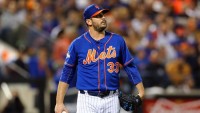Ruben Tejada
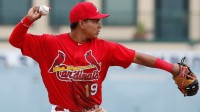
One of the interesting subplots to the 2016 season was going to be when Chase Utley stepped into the batter’s box against the Mets. One of the young Mets hurlers was going to have a chance to plunk Utley as retribution for what he did to their teammate, Ruben Tejada.
The problem is Tejada is no longer a Met. He’s a Cardinal. He’s off trying to help some other team try to win a World Series. When the Cardinals face the Dodgers, I’m sure it’ll be news that Utley and Tejada are facing each other for the first time since the NLDS. However, I doubt that Cardinals pitchers will be expected to exact revenge upon Utley for something that didn’t happen while Tejada was wearing a Mets uniform. Does this mean the Mets then have that obligation?
Do the Mets have to go out and plunk Utley? The message here is you went out and injured one of our own on a dirty play. We don’t care if Tejada is wearing another uniform or not, we will still stand up for our guys. It’s a message that the 2016 Mets will not back down to anybody. It’s a message that if you go after one of their players, you will have to answer for it.
Of course, it would be perfectly justifiable for the Mets to not plunk Utley. The 2016 Mets can still be the team that doesn’t back down to anyone without hitting Utley. While the Mets might still be upset over the play, Tejada is a Cardinal. They very reasonably could determine it’s up to the Cardinals to handle Utley now.
Overall, it’s fair to say the Mets are in a no-lose situation no matter how they choose to handle this situation. Actually, no, the Mets are in a no-lose situation so long as they don’t repeat the Shawn Estes situation.
Editor’s Note: this also appeared on metsmerizedonline.com
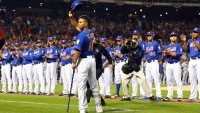
I’m sure Jedd Gyorko could be the answer to many questions. However, I’m fairly positive he’s not the answer to the question, “Who should be your starting shortstop?”
With the injury to Jhonny Peralta, Gyorko is the Cardinals starting shortstop. Unless the Cardinals make a move, Gyorko will be the shortstop for the next two to three months. Now, Gyorko was never anything more than an average second baseman which a career -1.5 UZR over his three year career. That doesn’t bode well for his chances to be a good to adequate shortstop. Like most, I’m assuming if any team can make it work, it’s the Cardinals.
With that said, it’s a good time for the Mets to call the Cardinals. From all the reports this Spring, it appears that the Mets might be looking to move on from Ruben Tejada. It’s probably the right move too.
Last year, Tejada had an impressive finish to the season. Although never mentioned as such, he was part of the reason why the Mets rallied to win the NL East. His gruesome injury in the NLDS was a rallying cry for the Mets and Mets fans throughout the postseason. However, he’s on the last year of his deal, and he’s an expensive backup eating up a spot on the 40 man roster.
The Mets right now have absurd depth at the shortstop position. Asdrubal Cabrera is penciled in as the starter the next two years. Wilmer Flores grew into the role and handled the position very well when pressed into shortstop duty again in the postseason. Former second round pick Matt Reynolds is competing for a utility role in the majors. On top of that, the Mets have two big shortstop prospects in Gavin Cecchini and Amed Rosario. Long story short, the Mets don’t need shortstop depth.
What they do need is 40 man roster space. So far, Jim Henderson is having a nice Spring and may be on the inside track to locking down a spot on the Opening Day bullpen. The Mets are talking about letting Kevin Plawecki start the year in AAA. This means, as of right now, Johnny Monell would open the year as the backup catcher. There’s a problem with Henderson and Monell making the Opening Day roster.
Neither player is on the 40 man roster, and the Mets have no spots open. Even if the Mets placed Zack Wheeler on the 60 day DL, the Mets would still need to drop someone else from the 40 man roster to add both Henderson and Monell. This could be accomplished by trading Tejada.
It seemed like Tejada turned a corner last year. Unfortunately, with one dirty play he is back on the bench, and frankly, occupying a roster spot the Mets need. It may not seem fair. It may seem cruel, but it’s time for the Mets too move on from Tejada. They should do it now with the Cardinals having a need, and the Mets wanting to maximize the return they would receive for Tejada.
Editor’s Note: this article also appeared on metsmerizedonline.com
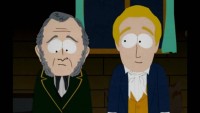
Well baseball just announced that even though Chase Utley broke Ruben Tejada‘s leg with a tackle, MLB is dropping the suspension:
https://youtube.com/watch?v=-ViF6JRNjTk
Even though Utley made a play no one has ever made before, baseball could find no reason to suspend Utley as “other players weren’t suspended for similar plays.”
https://youtube.com/watch?v=-ViF6JRNjTk
While MLB has stated players making a tackle like Utley did, a play not seen before, MLB said plays like this will be a suspendable offense in the future.
https://youtube.com/watch?v=-ViF6JRNjTk
Despite all evidence to the contrary, Utley doesn’t think his tackle had anything to do with the new rule.
https://youtube.com/watch?v=-ViF6JRNjTk
Utley’s agent stated, “It’s unfortunate that Chase got demonized by all of this. He has never intended to hurt another player.”
https://youtube.com/watch?v=-ViF6JRNjTk
In the same vein, MLB thought it was appropriate to suspend Hansel Robles for losing control of a quick pitch slider, which unfortunately came too close to a batter’s head.
https://youtube.com/watch?v=-ViF6JRNjTk
As a result, it will be fair to say the Mets pitcher who retaliates against Utley will receive a suspension for protecting his teammate.
https://youtube.com/watch?v=-ViF6JRNjTk
Overall, baseball messed up this whole situation from the beginning. Utley should’ve been ruled out. It should’ve been an inning ending double play as Utley interfered with Tejada’s attempt to turn a double play. Baseball then decided that it was reviewable because it couldn’t be a continuation play as Tejada didn’t make a throw. Keep in mind, Tejada couldn’t make a throw because his leg was broken by an illegal tackle.
Even though there was a rule on the books which establishes Utley’s slide was illegal, MLB determined a new rule was needed. Even though Utley’s slide forever changed Tejada’s career, baseball felt the unnecessary rule change was sufficient. There was no need to punish Utley because there was a new rule. Furthermore, even though there was no other tackle like Utley’s baseball determined since no play around second led to suspension before, Utley couldn’t be suspended.
There’s only one way to address how baseball addressed this whole situation is
https://youtube.com/watch?v=-ViF6JRNjTk
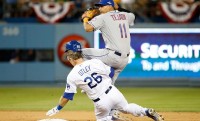
Whether you thought Major League Baseball needed a new slide rule or not, after Ruben Tejada‘s leg was broken by Chase Utley in the NLDS, a new slide rule was enacted. It specifically eliminated Utley’s previously impermissible tackle.
Actually, Utley disagrees with the notion he had anything to do with it. When questioned about the genesis of the new rule, Utley said, “From my understanding, I think we have been trying to work on this for a few years now, trying to get on the same page, and now we obviously are. I don’t think that one instance really determined anything.”
That pretty much sums it up right there.
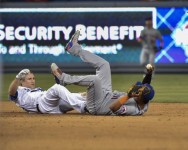
The short answer is no. A slightly longer answer is they’re not permitted to increase a suspension under the Collective Bargaining Agreement. With that said, I was pondering that question when I saw Hansel Robles agree to a two game suspension.
You know who else received a two game suspension? Chase Utley.
To put it in perspective, here are the two plays in question:
The optics of Robles’ pitch do not look good. It was a pitch by the head. He made the pitch in a game that had a number of hit batters, including Yoenis Cespedes right on the hands. The benches were warned. For his part, Robles states there was no intent. As Ron Darling points out, it was a slider that did not slide. It might’ve been because Robles tried to quick pitch the slider. Luckily, no one was hurt.
Now Utley went beyond just trying to break up a double play. He didn’t slide. He wasn’t in the baseline. As a result of his actions, he broke Ruben Tejada‘s leg. Utley forever changed Tejada’s career. For that, Utley received two games. Baseball actually tried to get him to agree to a one game suspension. Utley’s appeal of the suspension is still pending.
Think about that for a second. Whether or not you think Utley should’ve been suspended, how does it make sense for Robles to have a longer suspend io than Utley? Utley potentially altered someone’s career. He ended someone’s season. Robles had a pitch get away from him.
If you are going to say Robles was found to have done it intentionally, I disagree. However, it would raise a new question. How is throwing a ball at someone’s head only worth two games? That’s a dangerous play that should never be tolerated. To put it in perspective, Cole Hamels was suspended five games for hitting Bryce Harper in the small of his back.
These suspensions don’t make sense. They’re preposterous. If baseball really wants to protect players, they should throw the book at players who actually intend to injure players.
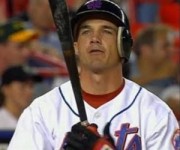
Whenever a prospect is coming through the system or a young player makes his way to the majors, invariably there is a comparison made to an All Star caliber player. Very rarely do we see a comparison to a utility player or a grinder like Joe McEwing.
With that said, if Matt Reynolds wants to be a part of this Mets team going forward, he will need to become this generation’s Super Joe.
Right now, Reynolds path to the majors is blocked. At the major league level, the Mets have Asdrubal Cabrera, Ruben Tejada, and Wilmer Flores provide extraordinary major league depth at the shortstop position. On the horizon, the Mets have two very well regarded shortstop prospects in Gavin Cecchini and Amed Rosario. For what it’s worth, Rosario is likely ticketed to play shortstop in AA, and Cecchini will be the shortstop in AAA. In short (pun intended), Reynolds will never be the shortstop for the Mets.
Even if he moves off of shortstop, his options are limited. He’s blocked at second by Dilson Herrera. Even if the younger Herrera were to falter, it’s much more likely that the Mets would turn to Cecchini or sign a free agent than Reynolds. Also, given his lack of power throughout the minors, it’s unlikely the Mets will turn to him go play third. No, Reynolds’ future, at least with the Mets, is as a utility player.
For his part, Reynolds is willing to play all over the field just to make it to the majors. He will play some outfield during Spring Training. As Reynolds told Adam Rubin, he knows a position change is in order:
No one has talked to me about it, but I heard about it from press conferences and everything. I’m willing to do whatever it takes to make it to the big leagues. I figured that I’d probably be changing positions. Honestly, I just look at it as it makes me more versatile, and there’s more opportunity for me to get called up and maybe stay up there.
Now, Joe McEwing was only a 28th round pick. When you are a 28th round pick, you are not seen as a prospect. You have to be ready, willing, and able to do whatever is necessary to get to the majors. It’s not only a talent issue. It’s a mindset. You have to show a lot of character and resiliency not only to make it to the majors, but also to stay there.
It was McEwing’s attitude and drive that helped him have a nine year career. It’s why Tony LaRussa requested a pair of autographed spikes from McEwing. He has the type of energy and drive that is infectious. It’s why he was a useful player. It’s why teams loved having him on the roster. It’s why he stays in the game as a major league coach and is a potential manager.
Reynolds was a second round pick. Typically, second round picks are not seen as utility players. As long as they produce, they usually have an easier path to the majors. With that said, it’s no guarantee. At some point, every player faces a turning point in their careers. For Matt Reynolds, that time is now. It’s time for him to embrace his future as a utility player.
Seemingly, he’s doing that. If he meets this challenge with the same drive and enthusiasm that McEwing once did, Reynolds has a real future not just with the Mets, but in baseball. It’s quite possible Reynolds’ future with the Mets is this generation’s Joe McEwing. Right now, Reynolds seems ready to do what is necessary to get to that point.
If he does, that means Reynolds will have a fine major league career.
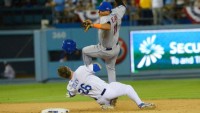
Next year, Chase Utley is going to be a utility player. He going to be a utility player because he’s 37 years old, and he has diminishing skills. He could retire, but he decided to hang around for another year or two. He’s not in this situation because someone injured him.
Last year, Ruben Tejada was not the starting shortstop on the Opening Day roster for the first time in his career. No, last year, the job was given to Wilmer Flores. Tejada was going to be a utility player to start the season. Then something strange happened. For all the years of the Mets just handing him the job, and him failing to hold onto it, Tejada finally rose to the challenge the year the job wasn’t just handed to him.
Last year, Flores had his offensive and defensive struggles. The Mets team was decimated by injuries. Tejada got some regular playing time. He then got some time at shortstop. He showed that while he had less range than Tejada, he had a steadier hand. More importantly, he began to hit:
- July .287/.330/.347
- August .235/.381/.294
- September .297/.357/.406
He entered the postseason as the Mets starting shortstop over Flores. He earned that right. Then with one dirty play Chase Utley took it all away. Tejada broke his leg. In the offseason, while he was hobbling around with a walking boot, the Mets signed Asdrubal Cabrera to take his place.
Utley reportedly reached out to David Wright to apologize to Tejada. He reportedly sent Tejada some things in the offseason. For his part, Tejada says all he wants is an apology.
Up until now, Utley has gone on and on about how he was playing hard and that he was playing the right way. However, his actions at least show remorse. The reason for this is he broke an unwritten rule, perhaps the most important rule amongst all players in all sports. You don’t injure other players with dirty, or even borderline plays. You don’t ruin another player’s career. Utley did that.
Utley took away Tejada’s job with one dirty play. Like Utley, Tejada is now a utility player. For what it’s worth, Tejada is not letting this hold him back:
I’m going to keep working hard, you never know what’s going to happen here. I want to stay focused all the time.
In 2015, Tejada was a utility player to start the season, and he finished the year as the starting shortstop. Utley put him back in that position this year. I’m not counting out Tejada this year, especially with dirty players like Utley out there.

While everyone is trying to decipher the outfield configuration after the Yoenis Cespedes signing, there is the issue of how the signing puts added importance on Wilmer Flores‘ ability to be a backup infielder.
Third Base
Make no mistake. The Mets need Flores to be able to handle the role and handle it well. For starters, we do not know David Wright‘s ability to withstand a full 162 game schedule. Last year, Wright had difficulty playing three days in a row. It impacted his offense and defense. With a full offseason to continue the extra work needed due to his spinal stenosis, that could change for Wright. It also may be a new reality.
Flores has to be ready, willing, and able to play third at a monent’s notice. In his major league career, Flores has only played 209 innings at third base. During that limited time, he did show the ability to handle the position. The problem is he has to work on his third base defense while addressing his second base defense.
Second Base
When the Mets acquired Neil Walker to replace Daniel Murphy, the Mets obtained a switch-hitting second baseman who has hit .272/.338/.427 over the course of his career. That’s with him coming off the worst year of his career last year when he hit .269/.328/.427 with 16 homers and 71 RBI. One of Walker’s issues last year was left-handed pitching. Walker hit a dreadful .237/.284/.290 in 62 games against lefties. For his career, Walker has hit an underwhelming .260/.317/.338 against lefties in his career. Effectively, Walker is a platoon player.
Ideally, that platoon parter would be Flores. However, Flores has to be able to hit lefties himself. Last year, Flores did that with aplomb. In 57 games, Flores hit .310/.355/.600 with 7 of his 16 homers against lefties last year. However, for his career, Flores has only hit .230/.288/.403 against lefties in his brief major league career. Overall, for the Walker trade to work Flores needs to be the 2015 version of himself against lefties as opposed to what he’s done against them in his entire career.
First Base
First base is where it starts to get dicey for Flores. With the Cespedes signing, Lucas Duda became the only player on the roster with any major league experience at first base. This forces Flores to learn a new position in addition to keeping prepared for his other backup roles.
How much Flores is needed will depend on Duda. Last year, Duda hit a respectable .285/.333/.545 with seven homers and 21 RBI in 82 games. However, much of that was fueled by an extraordinarily high BABIP of .385. For his career, Duda has hit .229/.301/.369 with a .321 BABIP. In short, Duda is due for a regression against lefties. It will be Flores’ job to cushion the fall back to earth while hoping his numbers against lefties doesn’t regress either.
Shortstop
The Mets signed Asdrubal Cabrera to be the new everyday shortstop. A role that used to belong to Flores. Cabrera’s backup to open the season should be Ruben Tejada, who actually wrestled the shortstop job away from Flores last year.
Here’s the issue. The one spot Flores isn’t backing up is the one spot he’s most needed. Last year, Cabrera had a -6.0 UZR and a -7 DRS at shortstop. For his career, he has a -55.5 UZR and a -29 DRS at short. Tejada had a -5.6 UZR and a -15 DRS at short last year. For his career, he has a -1.5 UZR and a -20 DRS there. Flores had a -2.5 UZR and a -10 DRS at short last year with a 1.5 UZR and a -13 DRS for his career.
So defensively, Flores is the best shortstop option. However, the Mets are going with Cabrera in the hopes that his .328/.372/.544 second half will carry forward because otherwise the Mets signed a shortstop who has hit .249/.307/.405 in the three years since his last All Star appearance. Ironically, the position Flores is best suited to on this team is not a position he is tops on the depth chart going into next season.
Pinch Hitter
Since this is the National League, Flores will need to be ready to pinch hit for the pitcher or for a left handed when a LOOGY enters the game. In his career, Flores has only had 13 plate appearances where he hit .250/.308/.333. These are around his career numbers of .253/.287/.386. Accordingly, Flores can reasonably be expected to replicate his career batting line as a pinch hitter next year. Whether that’s good or not is a whole other matter.
Conclusion
Surprisingly, much of what the Mets want to do lies on Flores’ shoulders. He had to platoon at second. He had to hit against tough left-handles while playing first. He has to be available at a moment’s notice to play third. He’s available to play each and every one of these roles because the Mets are placing their top shortstop option, Flores, on the bench.
Flores is still only 24 years old. He works hard, and he will do everything he can do to improve and help the team. He’s going to need to be proficient in three to four infield positions because the Mets really need his help.
Editor’s Note: this article first appeared on metsmerized.com
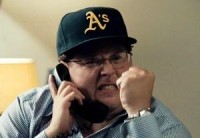
From what I gather from reading incorrect interpretations of the book, I take many people did not actually read Moneyball. If you haven’t, you should go and read it. If you have, now is the time to re-read it.
The reason to re-read it now is the script for the Mets postseason lies within those pages. I know Sandy Alderson was no longer the A’s GM at the time; it was Billy Beane. However, remember Beane’s top two lieutenants were J.P. Riccardi and Paul DePodesta. Until recently, they were Alderson’s top lieutenants. They were at least in place when the Mets were creating their offseason plans.
One of the many aspects of the book, which the movie seemed to get purposefully wrong, was how the A’s went about replacing Jason Giambi and one-year rental Johnny Damon. In essence, the A’s determined they flat out didn’t have enough money to replace these guys with other high priced players. Instead, the A’s were going to have to replace their production using a different line of thinking. I’m summing up here and being a little over simplistic, but here was the thought process:
- The team needed to identify what was undervalued on the free agent market (OBP);
- They needed the cumulation of their entire roster to replace Giambi and Damon since they couldn’t just sign two big name free agents to do it; and
- They needed to do it as cheaply as possible.
So what did they do? Well we know the Scott Hatteberg story with him being moved to first due to his traditionally high OBP (more on that later). In the movie and most other places, the story behind the David Justice acquisition is plain wrong. The A’s obtained him from the Mets, not the Yankees, in exchange for a LOOGY by the name of Mark Guthrie and a mistake waiting to happen by the name of Tyler Yates. It was the Mets, not the Yankees, who kicked in salary. It was only $1.2 million.
Now for the moves that haven’t received much fanfare. The A’s handed the secondbase job to a young Mark Ellis, who was capable of higher production than last year’s second baseman Frank Menechino. Menechino was moved to the bench to create a deeper roster. The A’s traded for Carlos Pena, who was a promising young player. Pena was supposed to be the first baseman with Hatteberg at DH and Justice in LF. That’s the way it was up until the trade deadline. They also traded for Billy Koch to sure up the closer’s role for the departed Jason Isringhausen.
By design, the A’s replaced Giambi and Damon not only with Pena and Justice, but by also improving their DH spot (Olmedo Saenz and Jeremy Giambi) and secondbase. In essence, the A’s added three new starters putting their old starters on the bench. The A’s left some payroll flexibility and had assets for the trade deadline.
The A’s used Pena in a three way trade to acquire Ted Lilly to sure up the rotation behind their three young big pitchers. They then used a prospect to acquire Ray Durham to DH with some needed cash. Hatteberg moved to be the full time first baseman. And yes, like in the movie, the A’s also added Ricardo Rincon to be the LOOGY to sure up the bullpen.
Did it work? If you look at the record, it absolutely did. They went from a 102 win team to a 103 win team. However, the reason wasn’t Hatteberg or Rincon. No, the part we forget is Barry Zito won the Cy Young, and Miguel Tejada win the MVP. They were powered by an insane 20 game winning streak. Lost in that streak was the A’s played only one team over .500 and played two teams that lost over 100 games that year.
The 2002 A’s got top notch performances from their top guys, and they made sure to beat the teams they were supposed to beat. Make no mistake. The 2002 A’s were worse. They scored 84 less runs and allowed nine more runs. However, at the end of the day, it didn’t matter. They won one more game.
The Mets are in a similar position as the A’s were. Make no mistake about it, the Mets have limited funds. With those funds, they needed to go out and replace the production of Daniel Murphy and a half a season of Yoenis Cespedes. Last year, Murphy hit .281/.322/.449 with 14 homers and 73 RBI. Cespedes hit .287/.337/.604 with 17 homers and 44 RBI in his time with the Mets.
We already know how the Mets replaced that production. They traded for Neil Walker, who hit .269/.328/.427 with 16 homers and 71 RBI. He’s a career .272/.338/.431 hitter. The Mets then decided to go with a platoon in center. There is in-house option Juan Lagares to hit against lefties. He hit .273/.333/.438 against lefties last year and .279/.325/.427 for his career. Platooning with him is Alejandro De Aza, who hit .278/.351/.448 against righties last year and .274/.338/.418 for his career. Now, this isn’t enough to replace the production of both of Murphy and Cespedes.
That’s where Asdrubal Cabrera comes in. Last year, Wilmer Flores played the bulk of time at shortstop hitting .263/.295/.408. Ruben Tejada played a lot there hitting .261/.338/.350. The Mets hoped by signing Cabrera they have significantly upgraded the position to cover the loss of Murphy and Cespedes. Cabrera hit .265/.315/.430 last year with the Rays. Speaking of replacing Cespedes’ second half production Cabrera hit .328/.372/.544 in the second half last year. Tangentially, the bench is theoretically better by having Flores and Tejada there.
Following the script they invented in Oakland, the Mets have already done what they believe they needed to do to replace the production they have lost. Right now, the Mets projected payroll is ~$106 million or about $4 million less than the 2015 payroll. Accordingly, the Mets are maintaining payroll flexibility like the A’s did so they can make trades at the deadline.
And, by the way, the Mets are powered by their three big young starters. How will it work out in 2016? We don’t know yet. However, if history is any lesson, the 2016 Mets will be worse than the 2015 version. If they want to have a better record, the 2016 Mets will need to take advantage of their games against bad teams like the Phillies and Braves. One of the young pitchers will have to step up even more. We’ll see which everyday player can step up to have the Tejada-like season.
